#Angular developer tools
Explore tagged Tumblr posts
Text
#AI code quality Angular#AI tools for Angular developers#AI-powered debugging Angular#Angular code optimization AI#Angular code review AI#Enhance Angular code quality using AI#Improve Angular code with AI
0 notes
Text
Top Tools for Web Development in 2025
Web development is an ever-evolving field, requiring developers to stay updated with the latest tools, frameworks, and software. These tools not only enhance productivity but also simplify complex development processes. Whether you’re building a small business website or a complex web application, having the right tools in your toolkit can make all the difference. Here’s a rundown of the top…

View On WordPress
#Angular Framework#API Development Tools#Back-End Development Tools#Best Tools for Web Development 2024#Bootstrap for Responsive Design#Django Python Framework#Docker for Deployment#Front-End Development Tools#GitHub for Developers#Laravel PHP Framework#Modern Web Development Tools#Node.js Back-End Framework#Popular Web Development Software#React Development#Tailwind CSS#Testing and Debugging Tools#Vue.js for Web Development#Web Development Frameworks
0 notes
Text
How Angular Streamlines Complex Mobile App Development Projects

Mobile applications have become an essential aspect of modern life in the rapidly evolving digital landscape. From social networking to online shopping, mobile apps drive much of the modern experience. However, creating these apps is not a straightforward process, especially when dealing with complex mobile app development projects that require scalability, high performance, and cross-platform functionality. Enter Angular, a powerful framework that has revolutionized the way developers approach angular mobile app development. Angular simplifies even the most challenging development tasks, enabling the creation of high-quality, scalable, and efficient mobile applications.
Understanding Angular
Angular is a comprehensive framework developed by Google for building dynamic single-page applications (SPAs). Angular is built using TypeScript, an enhanced version of JavaScript that incorporates static typing for improved reliability and scalability. Angular's component-based architecture allows developers to break down an application into smaller, reusable parts, making it easier to manage and scale large mobile app development projects.
Essential Benefits of Angular in Mobile App Development
Angular offers several features that make it a preferred choice for mobile app development projects:
Component-Based Architecture: Angular’s architecture allows developers to build applications by combining multiple components. Angular's modular design allows for easier management of complex applications, facilitating scalability as projects grow.
Two-Way Data Binding: This feature ensures that any change in the user interface (UI) is automatically reflected in the application's data model and vice versa. Its ability to ensure smooth synchronization simplifies the overall development workflow.
Dependency Injection: Angular’s built-in dependency injection framework allows developers to create modular, maintainable, and testable code, enhancing the efficiency of angular mobile app development.
TypeScript Support: Angular is built with TypeScript, which provides static typing and advanced features that help catch errors early in the development process, leading to cleaner and more robust code.
Angular CLI: The Angular Command Line Interface (CLI) is a powerful tool that automates the setup, development, and testing processes. This allows developers to follow best practices effortlessly and speeds up mobile app development projects.
Challenges in Complex Mobile App Development
Developing a mobile application, especially in the context of angular mobile app development, presents several challenges:
Scalability: As applications grow, maintaining their performance and managing their complexity can become difficult.
Performance Optimization: Ensuring that an app runs smoothly under heavy load requires careful planning and optimization.
Cross-Platform Compatibility: Building apps that function consistently across different platforms, such as iOS and Android, is often a complex task.
Security: Protecting user data and ensuring the app is secure from potential threats is a critical concern in mobile app development projects.
Angular addresses these challenges head-on, providing tools and techniques that simplify the development of complex mobile applications.
How Angular Simplifies Mobile App Development Projects
Angular’s comprehensive feature set makes it particularly effective for managing complex mobile app development projects:
1. Modular and Scalable Architecture
Angular’s component-based structure allows developers to divide the application into smaller, self-contained modules. This modularity makes it easier to scale the application and manage its complexity as it grows. New features can be added without affecting the existing codebase, which is crucial for large-scale mobile app development projects.
2. Cross-Platform Capabilities
Angular enables developers to build cross-platform mobile applications using frameworks like Ionic and NativeScript. These tools allow developers to leverage Angular’s architecture to create mobile apps that work seamlessly across different platforms. This not only reduces development time but also ensures a consistent user experience, a key aspect of successful mobile app development projects.
3. Speed and Efficiency in Development
The Angular CLI is a game-changer for angular mobile app development. It automates many routine tasks, from code generation to deployment, ensuring that developers can focus on writing quality code. The CLI also enforces best practices, which helps in maintaining code consistency and quality across the project.
4. Performance Optimization
Angular offers several features that optimize the performance of mobile applications:
Ahead-of-Time (AOT) Compilation: Angular compiles TypeScript and HTML code into highly optimized JavaScript code during the build process, which results in faster load times and improved performance.
Change Detection: Angular’s change detection mechanism automatically updates the UI whenever the model changes, ensuring that the application remains responsive and performs well even under heavy load.
Lazy Loading: Angular’s lazy loading feature allows the app to load only the necessary components as needed, reducing the initial load time and improving overall performance.
5. Enhanced Security
Security is paramount in mobile app development projects, and Angular provides several built-in features to protect applications:
Content Security Policy (CSP): This helps prevent Cross-Site Scripting (XSS) attacks by specifying which resources can be loaded in the app.
Strict Contextual Escaping (SCE): Angular ensures that the data displayed in the UI is sanitized and safe, preventing security vulnerabilities.
HTTPS and Authentication: Angular offers built-in support for HTTPS and diverse authentication methods, ensuring secure data transmission and robust user protection.
Real-World Applications of Angular
Several well-known companies have successfully used Angular to manage their mobile app development projects:
Google: Google uses Angular in many of its products, including Google Ads and Google Cloud Console, demonstrating the framework’s ability to handle complex, large-scale applications.
Microsoft Office 365 Integration: Angular drives key components within Office 365, delivering a consistent user experience across multiple platforms and devices.
These examples highlight Angular's versatility and effectiveness in simplifying complex mobile app development projects.
Conclusion
Angular has established itself as a powerful framework for mobile app development projects, offering developers the tools they need to build scalable, high-performance, and secure applications. Whether you’re working on a small project or a complex enterprise-level application, Angular’s features, including its modular architecture, cross-platform capabilities, and performance optimization tools, make it an ideal choice. As mobile app demands continue to grow, Angular remains at the forefront, simplifying the development process and enabling the creation of innovative mobile applications.
FAQs
1. Why is Angular an ideal choice for mobile app development projects?Angular’s component-based architecture, TypeScript support, and robust CLI make it an excellent choice for managing complex mobile app development projects, ensuring scalability and efficiency.
2. Can Angular be used for cross-platform mobile app development?Yes, Angular can be paired with frameworks like Ionic and NativeScript to create cross-platform mobile apps that work seamlessly on both iOS and Android.
3. How does Angular improve the performance of mobile apps?Angular optimizes mobile app performance through AOT compilation, efficient change detection, and lazy loading, all of which contribute to faster load times and responsiveness.
4. How secure is Angular for mobile app development? Absolutely. Angular includes built-in security features like Content Security Policy (CSP), Strict Contextual Escaping (SCE), and support for HTTPS, ensuring your mobile app is protected from common threats. 5. Why is Angular a good choice for large-scale mobile app development projects? Angular’s modular and scalable architecture, combined with its extensive feature set, makes it ideal for handling the complexities of large-scale mobile app development projects.
#Angular mobile app development#Complex mobile app projects#Streamlining app development#Angular for developers#Mobile app scalability#Efficient app development#Angular framework benefits#Modern app development tools#App project management with Angular#Advanced mobile apps#Angular coding efficiency#Mobile app frameworks#Simplified app architecture#Mobile development trends#Angular vs other frameworks
0 notes
Text
Navigating the Future of Web Development: Emerging Trends in Designing Services

In the ever-evolving landscape of net development, staying ahead of rising tendencies is critical for designers and builders alike. With new technologies and design methods continuously reshaping the virtual world, navigating the destiny of web improvement requires a eager understanding of the latest improvements and first-rate practices. In this article, we are able to explore the key developments in designing services which might be shaping the destiny of internet improvement.
Artificial Intelligence in Web Design :
AI-powered design tools are revolutionizing the manner websites are built, permitting designers to create customized and dynamic person reports. Machine gaining knowledge of algorithms can analyze consumer behavior and possibilities to optimize websites for improved engagement and conversion charges. “AI and machine studying are reshaping the manner we method internet design, allowing us to create greater tailor-made and consumer-centric reports.
Mobile-First Approach and Responsive Design :
With the bulk of net customers getting access to web sites on cell devices, a cell-first technique has emerge as critical for net designers.
Responsive layout ensures that web sites show effectively on all display sizes and devices, providing a unbroken consumer revel in.
Dark Mode Aesthetics
Dark mode has received reputation for its glossy and present day aesthetic, reducing eye strain and improving clarity in low-light environments.
Minimalist layout standards cognizance on simplicity and clarity, emphasizing critical content whilst lowering visible litter.
Voice Search and Navigation :
Voice interfaces have become an increasing number of not unusual in net design, allowing users to engage with websites the usage of voice commands.
Accessibility capabilities along with display screen readers and alt text make sure that web sites are inclusive and person-friendly for all individuals.
Sustainable Web Design :
Sustainable design practices prioritize strength performance, reducing carbon footprints, and minimizing environmental effect in web development.
Green hosting services and green layout alternatives contribute to a extra sustainable and accountable digital ecosystem.
Conclusion As we navigate the ever-changing panorama of net development, embracing rising developments in designing services is essential to staying applicable and aggressive in the virtual global. From AI-powered layout gear to sustainable internet practices, the future Blockverse Infotech Solutions of web development holds interesting possibilities for innovation and creativity. By staying informed and adapting to new technology and design processes, designers and developers can shape the destiny of net development and create splendid digital studies for users. Remember, the important thing to achievement in net development lies in continuously studying, experimenting, and embracing change to create memorable and impactful web sites for the modern-day virtual age.
#full stack developer#web designing company#web design company india#website designing services#react developer tools#backend and frontend services#website development cost#javascript developer#freelance website developer in jaipur#cheap web design india#angular developer#freelance website developer in
0 notes
Text
In a world where security is paramount, Java looks to be an unrivaled platform getting better with every new update. It is a premier programming language and an extraordinary ecosystem with the ability to deal with security concerns more effectively, thanks to its important tools and libraries.
Another aspect of Java’s unrivaled success is its “Write Once, Run Anywhere” principle. It doesn’t require recompilation when developing Java applications, which makes it the best choice for cross-platform software development.
Java is highly chosen for a wide range of projects, including AI/ML application development, Android app development, Bespoke Java software development, bespoke Blockchain development, and many more.
#java development#future of Java#java trends#java developer for hire#Java programming language for cloud-native development#Java frameworks for microservices architecture#Java ecosystem tools for DevOps automation#Java web development trends in 2023#Agile Java development with DevOps best practices#Java Development Unleashed#software development#angular development
0 notes
Text
REMOTE WORK - OPPORTUNITIES AND CHALLENGES FOR DEVELOPMENT COMPANIES | iFour Technolab

One of the challenges that remote employees of Software Development companies face is overwork. It becomes difficult to balance work and life when it is under the same roof. Even though working from home means working on different days or hours, and being flexible. But some employees tend to spend more time on work during the day which is not required. Due to this, they feel exhausted, sleep-deprived, and lack of personal time.
The workload does not allow the employee to focus on the essential tasks and leads to a significant decrease in productivity.
#Uw zoekopdracht eindigt hier#frantic teamwork brainstorming sessions#Build Angular Reactive Templates#include bad internet connections#organized remote team set#Heading upwards remote work#Software Ontwikkeling Diensten#Software Development companies face#include team members sharing#completely remote team set-up#use project management tools#team speaks different languages#collaboration tools available#Software Outsourcing Experiences#software development companies#promote real-time connectivity#Angular Dependency Providers#innovative technological tools
1 note
·
View note
Text

Navigating Deep Space by Starlight
On August 6, 1967, astrophysicist Jocelyn Bell Burnell noticed a blip in her radio telescope data. And then another. Eventually, Bell Burnell figured out that these blips, or pulses, were not from people or machines.

The blips were constant. There was something in space that was pulsing in a regular pattern, and Bell Burnell figured out that it was a pulsar: a rapidly spinning neutron star emitting beams of light. Neutron stars are superdense objects created when a massive star dies. Not only are they dense, but neutron stars can also spin really fast! Every star we observe spins, and due to a property called angular momentum, as a collapsing star gets smaller and denser, it spins faster. It’s like how ice skaters spin faster as they bring their arms closer to their bodies and make the space that they take up smaller.
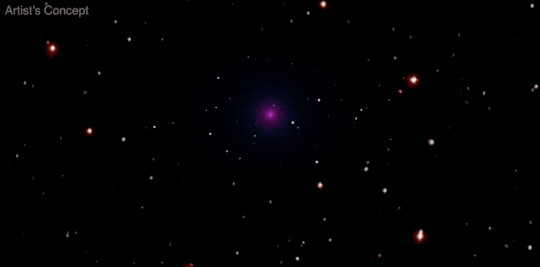
The pulses of light coming from these whirling stars are like the beacons spinning at the tops of lighthouses that help sailors safely approach the shore. As the pulsar spins, beams of radio waves (and other types of light) are swept out into the universe with each turn. The light appears and disappears from our view each time the star rotates.

After decades of studying pulsars, astronomers wondered—could they serve as cosmic beacons to help future space explorers navigate the universe? To see if it could work, scientists needed to do some testing!
First, it was important to gather more data. NASA’s NICER, or Neutron star Interior Composition Explorer, is a telescope that was installed aboard the International Space Station in 2017. Its goal is to find out things about neutron stars like their sizes and densities, using an array of 56 special X-ray concentrators and sensitive detectors to capture and measure pulsars’ light.
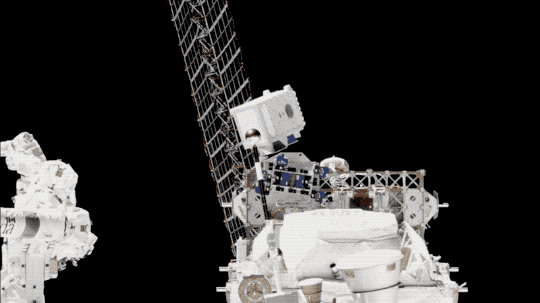
But how can we use these X-ray pulses as navigational tools? Enter SEXTANT, or Station Explorer for X-ray Timing and Navigation Technology. If NICER was your phone, SEXTANT would be like an app on it.
During the first few years of NICER’s observations, SEXTANT created an on-board navigation system using NICER’s pulsar data. It worked by measuring the consistent timing between each pulsar’s pulses to map a set of cosmic beacons.

When calculating position or location, extremely accurate timekeeping is essential. We usually rely on atomic clocks, which use the predictable fluctuations of atoms to tick away the seconds. These atomic clocks can be located on the ground or in space, like the ones on GPS satellites. However, our GPS system only works on or close to Earth, and onboard atomic clocks can be expensive and heavy. Using pulsar observations instead could give us free and reliable “clocks” for navigation. During its experiment, SEXTANT was able to successfully determine the space station’s orbital position!

We can calculate distances using the time taken for a signal to travel between two objects to determine a spacecraft’s approximate location relative to those objects. However, we would need to observe more pulsars to pinpoint a more exact location of a spacecraft. As SEXTANT gathered signals from multiple pulsars, it could more accurately derive its position in space.
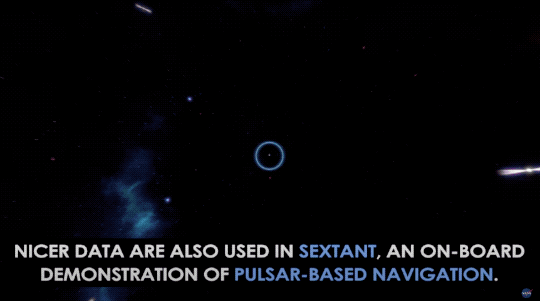
So, imagine you are an astronaut on a lengthy journey to the outer solar system. You could use the technology developed by SEXTANT to help plot your course. Since pulsars are reliable and consistent in their spins, you wouldn’t need Wi-Fi or cell service to figure out where you were in relation to your destination. The pulsar-based navigation data could even help you figure out your ETA!

None of these missions or experiments would be possible without Jocelyn Bell Burnell’s keen eye for an odd spot in her radio data decades ago, which set the stage for the idea to use spinning neutron stars as a celestial GPS. Her contribution to the field of astrophysics laid the groundwork for research benefitting the people of the future, who yearn to sail amongst the stars.
Keep up with the latest NICER news by following NASA Universe on X and Facebook and check out the mission’s website. For more on space navigation, follow @NASASCaN on X or visit NASA’s Space Communications and Navigation website.
Make sure to follow us on Tumblr for your regular dose of space!
#NASA#pulsar#Jocelyn Bell Burnell#spaceblr#space#star#neutron star#deep space#telescope#navigation#universe#astronomy#science
4K notes
·
View notes
Text
Essentials You Need to Become a Web Developer
HTML, CSS, and JavaScript Mastery
Text Editor/Integrated Development Environment (IDE): Popular choices include Visual Studio Code, Sublime Text.
Version Control/Git: Platforms like GitHub, GitLab, and Bitbucket allow you to track changes, collaborate with others, and contribute to open-source projects.
Responsive Web Design Skills: Learn CSS frameworks like Bootstrap or Flexbox and master media queries
Understanding of Web Browsers: Familiarize yourself with browser developer tools for debugging and testing your code.
Front-End Frameworks: for example : React, Angular, or Vue.js are powerful tools for building dynamic and interactive web applications.
Back-End Development Skills: Understanding server-side programming languages (e.g., Node.js, Python, Ruby , php) and databases (e.g., MySQL, MongoDB)
Web Hosting and Deployment Knowledge: Platforms like Heroku, Vercel , Netlify, or AWS can help simplify this process.
Basic DevOps and CI/CD Understanding
Soft Skills and Problem-Solving: Effective communication, teamwork, and problem-solving skills
Confidence in Yourself: Confidence is a powerful asset. Believe in your abilities, and don't be afraid to take on challenging projects. The more you trust yourself, the more you'll be able to tackle complex coding tasks and overcome obstacles with determination.
#code#codeblr#css#html#javascript#java development company#python#studyblr#progblr#programming#comp sci#web design#web developers#web development#website design#webdev#website#tech#html css#learn to code
2K notes
·
View notes
Note
Hello! For scholars/scribes or everyday use, which writing system would be used, Cirth or Tengwar? The Dwarves adopt Cirth for their stone carving, but I would imagine that writing exclusively in cirth would put a lot of strain on writing instruments and, well, wrists because of how stiff and angular it is. IRL, cursive scripts are developed to write faster. In the film, the book of Mazarbul starts off in cirth but the last line is a messy cursive (poor Ori...). Do you have any thoughts?
Well met!
A question that touches not only on Tolkien’s linguistic worldbuilding but also on the real-world evolution of writing systems. You're absolutely right to point out the physical practicality of cursive scripts—and how that likely applied even in Middle-earth.
🪓 Cirth: A Script Born of Stone
The Cirth (runes) were initially devised by the Elves—most notably Daeron of Doriath—but the Dwarves adopted and refined them into Angerthas Moria, and later Angerthas Erebor, adapting the system for their own use.
Cirth was ideally suited for engraving in stone, wood, and metal. Its angular and straight-lined forms made it easy to carve with chisels—much like early real-world runes such as Futhark. And indeed, this seems to have been its primary intended function, at least originally.
But when applied to ink and parchment, Cirth presents obvious limitations:
Angularity = slower strokes
Frequent pen lifts = reduced efficiency
Hard on wrists during long writing sessions

✍️ Why Cursive Scripts Exist (Even in Middle-earth)
Historically, cursive scripts developed because they’re faster and more efficient to write. The word cursive itself comes from Medieval Latin cursivus, meaning “running”—derived from currere (“to run, hasten”). These scripts allow the writing tool to stay in contact with the surface, reducing effort and increasing speed.
Tolkien’s world, while fantastical, remains grounded in practical realities. The Dwarves were master craftsmen, engineers, merchants, and, at times, scholars. We know that they did not limit themselves to a chisel-optimised script for all writing contexts—especially not for ink.
📚 The Book of Mazarbul: A Key Piece of Evidence
Your mention of the Book of Mazarbul is absolutely on point—and yes, it offers a direct answer.
This chronicle, written by Balin’s folk in Khazad-dûm, includes multiple scripts:
Cirth of Moria and Cirth of Dale
Tengwar of the later Westron mode (which uses full vowel signs)
Gandalf identifies one page as being written in a “large bold hand using an Elvish script,” and Gimli confirms it as Ori’s. Most of the final page is in runes, but the very last line—“they are coming”—is scrawled in Tengwar.
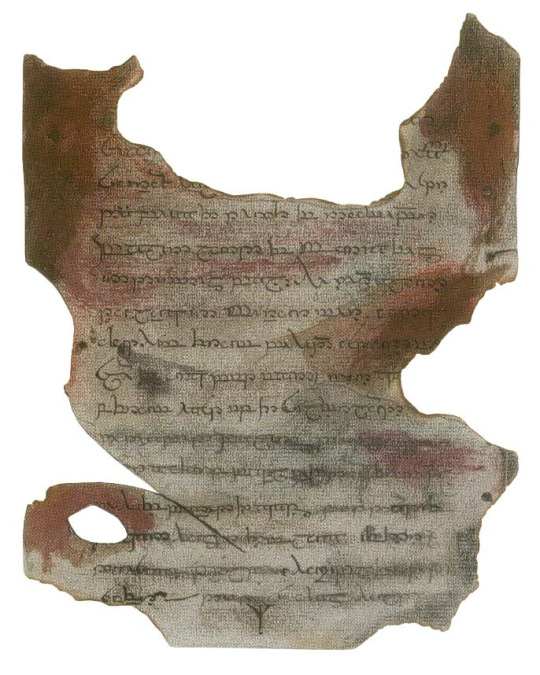
Facsimile of page II
What does this show?
Dwarves—at least those literate and especially the scholarly, like Ori—did use Tengwar, especially when writing quickly or when Cirth became impractical.
This was likely not an isolated case. It reflects a layered literacy among Dwarves, especially those in leadership, scribal, or administrative roles.
🔤 Tengwar vs. Cirth: Cultural Identity vs. Practicality
Tengwar was an Elvish invention, and the Dwarves never adopted it culturally (unlike Cirth that suited engraving better). But that doesn’t mean they rejected it entirely. Much like a medieval monk might write in Latin while speaking another tongue at home, Dwarves used Tengwar functionally—when the moment demanded it.
So what likely happened was this:
Cirth remained the culturally Dwarven script (with the Moria variant used when writing Khuzdul)—employed in inscriptions, tombs, weapon etchings, and formal records.
Tengwar, particularly the Westron mode, was known to educated Dwarves and used for efficiency, likely especially in:
Letters
Journals
Merchant ledgers
Emergency or field writing
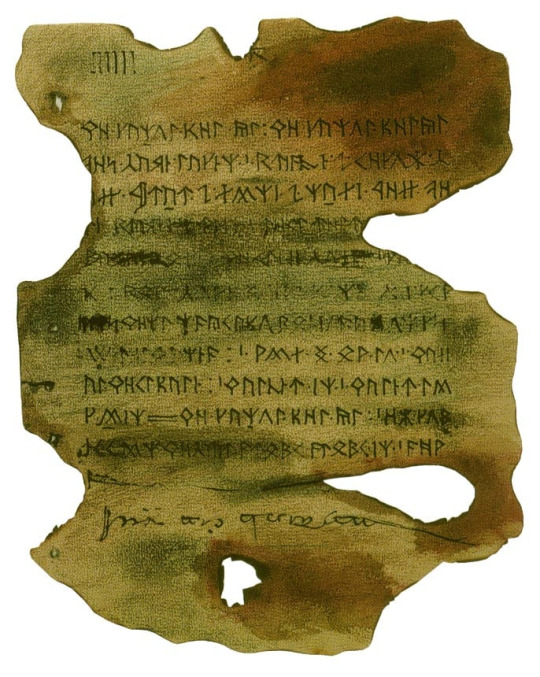
Facsimile of page III
🧾 Was There a Dwarven Cursive?
Tolkien never describes a “Dwarven cursive” variant of Cirth—but based on real-world linguistics and in-world logic, it’s possible one existed.
At the very least, a more fluid, ink-friendly variant of Cirth may have been used for day-to-day notes. But even so, the fact remains: Ori chooses Tengwar in a pinch, not cursive Cirth. That tells us that, if a Dwarven cursive did exist, it wasn't the go-to form—at least not when time was short and clarity was vital.
In short: the Dwarves were too practical not to use—or even develop—more efficient ways to write. Whether they did so by streamlining Cirth, or by using Tengwar when needed, they had options—and likely used them all.
🧠 Final Thoughts
Cirth was their script of identity—literally engraved into the stone, wood and iron that surrounded them.
Tengwar was a tool of practicality—adopted when writing had to move as fast as the moment demanded.
Tolkien shows us just enough (especially through Ori and the Book of Mazarbul) to draw this conclusion with confidence.
Ever at your service, The Dwarrow Scholar
33 notes
·
View notes
Text

Dr. Vyle
Age: 54
Profession: Head of R&D at Vykker’s Labs 16, surgeon
Species: Vykker
Dr. Vyle is the head of Research and Development at Vykker’s Labs 16, one of the most notorious laboratories on Oddworld and one of the only airships in the Conglomerate’s possession . Dr. Vyle is immediately recognizable by his four sleek metal arms, which replace his natural ones. These arms, each equipped with different surgical tools and gadgets, were self-engineered after a catastrophic lab accident left him permanently disfigured. His decision to create and graft these arms onto himself was driven by both necessity and his relentless obsession with scientific advancement. The arms provide him with enhanced precision during surgeries and experiments, allowing him to carry out intricate tasks faster than any other vykker.
Dr. Vyle’s perpetually furrowed brow and deep-set, glowing yellow eyes and sharp, angular features give him a look of constant, simmering anger—even when he’s simply focused on his experiments. As the head of Research and Development, Dr. Vyle oversees the most disturbing and groundbreaking experiments at Vykker’s Labs 16.
His expertise in surgery is unparalleled, and he often performs grotesque modifications on creatures for the Magog Cartel. From gene splicing to organ harvesting, Vyle is at the forefront of Oddworld’s most heinous scientific practices. His office is a chaotic mess of surgical tables, glass tubes filled with mysterious fluids, and rows of grotesque specimens—many still alive—suspended in jars. His mechanical arms allow him to conduct multiple procedures at once, making him a whirlwind of efficiency. However, this mechanical precision is also what makes him detached from any sense of empathy or morality
Dr. Vyle is intensely focused on his work, with little patience for distraction or incompetence. He’s known for being cold, calculating, and unfriendly, even among his fellow Vykkers, including his personal assistant, Lenny. His demeanor is clinical, but there’s a barely-contained frenzy in the way he operates. When presented with a new challenge or discovery, he becomes obsessively excited, though this excitement often takes a sinister form, especially when it involves invasive procedures or dissection. Like most other vykkers, Vyle has no moral compass—he views everything through the lens of monetary value and scientific curiosity. He is perpetually irked by anything that disrupts his carefully constructed world, and nothing vexes him more than unpredictability—especially when it comes in the form of one particular human girl.
Dr. Vyle’s life took an unexpected turn when he stumbled upon the human girl, Evie, floating unconscious in a river when the interns at the lab were retrieving captured test subjects in the forest. When she was first brought to him, he was immediately intrigued by her pale skin and unfamiliar anatomy with Vyle initially referring to the creature as “Specimen 117” with Vyle believing that she was some form of mutated mudokon or evolutionary offshoot until he heard her calls herself a “human”. Vyle’s excitement grew immensely when he realized that he could be dealing with an entirely new species that was likely worth astronomical amounts of moolah.
At the lab, the subject refused to cooperate despite her very obvious fear, and found ways to grate on Vyle’s nerves, with her yelling strange phrases and disrupting the invasive experiments Vyle attempted to perform on her. Evie one day freed herself from the lab by wiggling out of her restraints, knocking Lenny in the head, and stealing an elum meant to be used in an experiment and freeing several other test subjects before escaping the lab atop the elum.
The loss of Evie has enraged Vyle, and he has since issued a hefty reward for her return, spreading the lie that she is in fact a dangerous mutant and a threat to Oddworld. His reputation- and a significant amount of profits- rests on retrieving this elusive “human” and he will stop at nothing to have her back.
#my art#ocs#oddworld#this took way too long#oddworld vykker#vykker#Dr. Vyle#Evie#Lenny#watercolor#oc art#this all could change in the future
30 notes
·
View notes
Text
Assuming written alphabets/language systems (in part) look the way they do as a result of the writing instrument and the material being written on, I wonder how the G1 Cybertronian alphabet first developed its shape?
Taking a detour to Ancient Rome for a second, there’s a pretty stark difference between remaining evidence writing that was for public, official purposes (plaques, engravings, grave markers), handwritten (letters or documents on papyrus or wood), or carved graffiti (like on the walls of Pompeii). Official, public-facing plaques and monuments have very steady, very angular writing as a result of being carved or engraved into stone or metal by professionals. Roman handwriting, like what’s found on the Vindolanda tablets, is more thin and fluid. The letters can still be easily distinguished by someone familiar with the writing system, but the shapes of the letters don’t immediately look like those on official engravings. Carved graffiti hits a very interesting middle ground. It has more of the angular qualities of public-facing works while often retaining the thinner, closer-bunched letters of personal handwriting. The shapes of letters and symbols are impacted by the author, instrument, and medium.
So why does the G1 writing system look like that? They’re using digital systems by this point, but unless Primus created a ready-to-go writing system (which is honestly a completely valid possibility given the franchise), the symbols they’re using must come from somewhere.
My personal theory is Cybertronians used their fingers as their writing instruments at first, and wrote in something more malleable than metal. It makes sense to me that a species that uses their bodies in the way Cybertronians do (as most of the tools they need are already part of their bodies) would be more inclined to use their fingers as writing tools instead of something external.
Additionally, the letters have a specific angularity and thickness at certain points that look as though an instrument with a square or rectangular tip was used. Something thinner, like a knife or human pencil, would have a more difficult time making those same shapes naturally. The changes in thickness and angle could be from changes in pressure and direction of the finger when writing. Aspects that are particularly difficult to create with a square-tipped instrument, like the point on the equivalent to “N” could be explained as the result of an exaggeration/shift in how parts of the letters are drawn over time due to changes in writing tools.
Anyway! The honest answer is I just don’t know, but I’ve had a lot of fun writing this. Someone else has probably done this before (the fandom is 41 years old), but oh well! Now I’ve done it too :)
Please share your thoughts if you have any! I’d love to hear them
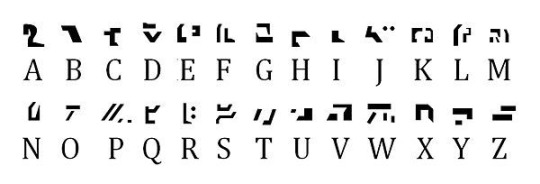

#transformers#maccadam#maccadams#cybertronian linguistics#cybertronian culture#cybertronian biology#cybertronian worldbuilding#cybertronians#classics#I guess?#robot thoughts#I AM NOT A LINGUIST PLEASE BE KIND
12 notes
·
View notes
Text
The History of Astrocartography and Relocation Astrology
The concept of locational astrology—the idea that geography influences a person’s astrological experience—dates back thousands of years, but astrocartography, as it is known today, was formally developed by Jim Lewis in the 1970s. His groundbreaking work provided a structured, visual method for mapping planetary influences across the globe, allowing individuals to understand how different locations enhance or challenge various aspects of their lives.
Early Influences on Locational Astrology
Although Jim Lewis pioneered modern astrocartography, the foundational ideas behind astrology and location have existed for centuries:
Ancient Mesopotamia and Egypt – Early astrologers observed the relationship between the stars, planetary movements, and earthly events. While their astrology was primarily focused on omens and collective fate, certain locations were believed to hold unique energetic influences.
Classical and Hellenistic Astrology – Greek and Roman astrologers like Ptolemy (2nd century CE) wrote extensively about how the zodiac and planetary movements influenced different geographical regions. In his work Tetrabiblos, Ptolemy connected astrological signs to specific parts of the world, a precursor to modern astrocartographic thinking.
Medieval and Renaissance Astrology – Astrologers in the Middle Ages refined techniques for solar revolutions and ingress charts, which allowed for predicting events in specific locations based on planetary movements. Some Renaissance-era astrologers also experimented with adjusting natal charts to different places.
20th-Century Developments – In the early 1900s, astrologers began experimenting with relocation charts, a practice that involves casting a birth chart as if a person had been born in a different location. However, it wasn’t until Jim Lewis’s work in the 1970s that these ideas were fully developed into a structured system.
Jim Lewis and the Birth of Astrocartography
Jim Lewis (1941–1995) was a visionary astrologer who transformed an obscure branch of astrology into a structured and accessible system known as astrocartography. While the concept of locational astrology was not new—perhaps tracing back to ancient times when stellar observations were used to determine significant locations—Lewis was the first to develop a fully integrated technique, combining detailed world maps, systematic written interpretations, trademarked software, commercial services, lectures, courses, published articles, and a certified examination in the field. His efforts made astrocartography a practical tool for astrologers and the general public alike.
Before Lewis’s innovations, relocation astrology was primarily practiced through relocation charts, which involved recalculating a natal chart for a different place but lacked a visual representation of planetary influences worldwide. His work bridged the gap between traditional astrological theories and modern technology, allowing people to see how planetary energies manifest in different locations in a way that was both structured and user-friendly.
Jim Lewis’s Key Contributions to Astrocartography
Developed Astrocartography as a Mapping System – By drawing planetary lines on a world map, Lewis provided an intuitive and visually accessible way to understand how different locations emphasize specific planetary energies.
Popularised the Use of Angular Planets – He demonstrated that planets aligned with the four powerful angular points—the Ascendant (ASC), Midheaven (MC), Descendant (DSC), and Imum Coeli (IC)—become dominant forces in a person’s experience when they are physically present in those locations.
Created the First Computer-Generated Astrocartography Maps – With the rise of computing, Lewis pioneered software-based astrology tools, making it possible to generate planetary maps quickly and with precision. This technological advancement was crucial in making astrocartography widely available.
Maintained a Rigorous and Scientific Approach – Unlike many astrologers of his time, Lewis adhered strictly to established astrological traditions, focusing on visible planets in angular positions. He followed the lineage of Ptolemy and the Chaldeans, and his work aligned with the scientific research of Michel and Françoise Gauquelin, who studied planetary effects statistically. While he accepted the addition of lines for Chiron, the Lunar Nodes, and the ecliptic, he rejected lines based on planetary aspects, despite their potential commercial appeal. His commitment to clarity and precision reflected his Saturn-Uranus conjunction in Taurus in his 10th house, embodying a balance between tradition and innovation.
Jim Lewis’s legacy endures as astrocartography remains one of the most widely used tools in modern astrology, empowering people to make informed decisions about relocation, travel, career opportunities, and personal growth based on the planetary influences active in different parts of the world.

Relocation Astrology: The Evolution of Place-Based Astrology
While astrocartography focuses on mapping planetary lines, relocation astrology is a separate but complementary technique that involves recalculating a person’s birth chart for a specific location. This method has been practiced since at least the early 20th century and provides additional insights into how a person’s natal planetary placements shift when they move.
How Relocation Charts Work: Instead of mapping planetary lines, a relocation chart recalculates the birth chart as if a person had been born in their new location, altering the house placements of planets. This can shift life priorities, influence major themes, and modify how planetary energies manifest.
Key Differences from Astrocartography: While astrocartography highlights specific planetary influences in different places, a relocation chart offers a deeper, house-based interpretation of how moving to a new location changes a person’s natal blueprint.
Astrocartography and Modern Astrology
Since Jim Lewis’s pioneering work, astrocartography has become a widely used tool in astrology, with continued refinements and applications:
Computer Software Advancements – Modern astrology software allows for highly detailed and interactive astrocartography maps, making the practice more accessible than ever before.
Integration with Relocation Astrology – Many astrologers now use a combination of astrocartography and relocation charts to provide a holistic view of how a place influences an individual.
Increasing Popularity in Travel and Life Planning – More people are using astrocartography not just for relocation, but also for short-term travel, career decisions, relationship guidance, and spiritual growth.
Final Thoughts
Astrocartography has its roots in centuries of astrological thought but was transformed into a practical system by Jim Lewis in the 1970s. His contributions allowed for a visual, structured approach to understanding how different locations influence a person’s life. While relocation astrology and astrocartography are distinct methods, they work together to provide a comprehensive picture of how geography affects personal growth, career, relationships, and overall life experience.
So by combining both techniques, astrology nerds like us can make informed decisions about where to live, travel, or seek opportunities, aligning ourselves with locations that support our unique astrological blueprint.
#astrology#astrology community#astrology tumblr#astrocartography#jim lewis#relocational astrology#relocation chart#astrology history#locational astrology
7 notes
·
View notes
Note
Hi Lee Cree!! I love your animations and I'm a big fan of styled Art and animations. I wanted to ask you how did you develop your art style, what brushes do you use, and did you go to an animation school!
Hello Night! Thank you so much for your support! As for your questions, Imma go backwards haha.
No, I didn't go to an animation school but a private fine arts college in Massachusetts. They did have an animation program but it was so new (4 years old) that it didn't have any real resources for me. So I ended up teaching myself how to animate the way I like.
Second, brushes. I've already answered the brush question in a previous ask . Though I will be honest in that I haven't really been using these brushes lately since I am a fickle being haha. But in all seriousness, I'm very much a default brush tool gal 'cause I don't really believe in a "brush tool that will make me draw better." By no means is this targeted towards you, Night, but I want people who are reading this to understand knowing an artist's specific brush tool and settings won't suddenly make your art change. You still have to learn how to use that tool in a way that works for yourself. For myself, I don't need fancy settings and effects. I'm the type of artist that will take a Crayola marker over a Copic marker because I just need something that works and will bend it to my liking. But as of right now, I've been using the default G-pen tool in Clip Studio with default settings (7-10px) 'cause I just like how it looks. I'm sure it'll change again but my point is that please don't get too fixated on what brushes I use because it's not as fancy as you think it is. ^^; Last one, style. So lemme let you in on a secret, Night: I don't really have a style haha. This is such a hard topic for me to explain because I....don't really care about "style" but rather I look for how artists execute certain things in art. I'm just good at breaking down someone's style and figuring out how they execute foundational drawing cornerstones. For example, Tite Kubo (Bleach) draws the lower of the face longer (which gives a more angular, mature look) as opposed to Furudate (Haikyuu) who draws the lower portion of face shorter than real life (which make the style read more youthful). This is something I learned during my time in art school since I mostly took fine arts classes. We often spent a lot of time dissecting other artists work and trying to replicate it. So, I approach my work in the sense where one day I'll go, "I'm gonna draw the eyes like Christie Tseng" but then the next day I'll go, "What if I drew the eyes like Mitsuru Adachi?" My "style" thrives off of learning the visual cues of artists and seeing if I can replicate it. And once I do, I adjust it to fit my sensibilities so I can add it to my arsenal of "styles" haha. And, if you've noticed that's how I'm able to switch up my drawing between shows like My Adventures with Superman and One Piece. And at the end of the day, what y'all are seeing is an accumulation of years of analyzing, deconstructing and reconstructing techniques from artists I really admire and trying to mix them together into something that feels uniquely me. And it's always changing. I think a lot of emerging artists can fall into the worry of not having a "distinct visual style" and in my art journey that visual style is just a result of practice, experience and experimentation. Of course, y'all can probably tell I'm super influenced by anime but outside of anime I'm also inspired by western artists (like Manet and Degas). I guess what I'm trying to say is that when it came to developing my "style" I gave up of being a "stand out" which was very freeing for me back in college. It allowed me to study artists outside of my field and experiment with their techniques to create my own unique hodgepodge you see today.
8 notes
·
View notes
Note
Do you have any specific appearances in mind for Alfie, Casper and Neige? I'm so curious, even if it's just a vague idea or direction.
Hmm, yes and no. Really, the only canon way they look are their descriptions in the show. But there are some things to do with the way they look which I've given a lot of thought to which I'll kind of. Waffle about. These are not really canon things, though, and fall instead into a category of dubious canon, where bc I'm the author I can't really fully escape the implication that everything I say about these little guys has more authorial power, but also this is stuff that's not necessarily consistent or anything that would come up within the show itself.
In the beginning I wasn't really thinking much about how Cas looked beyond the fact he has a lot of very dark, curly and wavy hair, which he should probably take better care of but just doesn't have the emotional bandwidth. I don't think he'd ever cut it off, though, it's important to him. Besides his hair and the angularness of his features, he changes in my head when I picture him in my head. Pretty consistently he has kind of medium toned skin, which you get the impression would be a lot darker if he was able to be in the sun more. When he does go out in it now, he tans fast and gets an extraordinary amount of freckles. He has brown eyes and very angular features, a long nose, a sharp brow. He's tall, ish, but not massively so. He has kind of a medium build, he clearly takes care of his body, but it's all for function, not for looks. He dresses in a way that's not exactly untidy, but I think he sort of just. Puts clothes on his body rather than carefully dressing himself in outfits, if you know what I mean?
By contrast, Neige is small, below average height, and his features are sort of soft and androgynous. His hair is pale gold and very well looked after. He likes to keep it cropped in a similar style to that you see on greek statues, but he has been known to let it grow longer if that's fashionable. There's an almost cherubic softeness to him, in my head. His hair and his skin, all shades of gold, but his eyes are a very striking blue, so when his kill drive is activated and they turn red, it's very noticeable. It totally shifts the colour tone of his face from angellic/ethereal to earthen and fiery. Neige also ✨gets dressed✨ like he is going for a look pretty much whenever he's choosing clothes. Is he fashionable in the sense that he's on trend? Fuck no. But there's something bold and stylish about him, having just decided to put on whatever he thinks makes him look hottest. I think he's accutely aware of his prettiness and sees it as a potential power. He uses his clothes to accentuate that where he can. Basically, for Neige, his body is first and foremost a tool, and you ought to keep your tools in the best condition possible so they can be functionally optimised.
Because I think of the show from Alfie's perspective, his appearance is the least developed. I think he has a lot of issues with his looks, but he's not hateful of himself. He's like. An average amount of good looking. He puts time and effort into how he styles himself when he has the energy to, but there hasn't been a lot of time for that since the events of the show started, poor lamb. He has mousy brown hair which he thinks is boring, a lot of freckles.
I hope that was at least fun if not necessarily informative!!!
--- Eira xxx
42 notes
·
View notes
Text
What Is The Difference Between Web Development & Web Design?
In today’s world, we experience the growing popularity of eCommerce businesses. Web designing and web development are two major sectors for making a difference in eCommerce businesses. But they work together for publishing a website successfully. But what’s the difference between a web designers in Dubai and a web developer?
Directly speaking, web designers design and developers code. But this is a simplified answer. Knowing these two things superficially will not clear your doubt but increase them. Let us delve deep into the concepts, roles and differentiation between web development and website design Abu Dhabi.

What Is Meant By Web Design?
A web design encompasses everything within the oeuvre of a website’s visual aesthetics and utility. This might include colour, theme, layout, scheme, the flow of information and anything related to the visual features that can impact the website user experience.
With the word web design, you can expect all the exterior decorations, including images and layout that one can view on their mobile or laptop screen. This doesn’t concern anything with the hidden mechanism beneath the attractive surface of a website. Some web design tools used by web designers in Dubai which differentiate themselves from web development are as follows:
● Graphic design
● UI designs
● Logo design
● Layout
● Topography
● UX design
● Wireframes and storyboards
● Colour palettes
And anything that can potentially escalate the website’s visual aesthetics. Creating an unparalleled yet straightforward website design Abu Dhabi can fetch you more conversion rates. It can also gift you brand loyalty which is the key to a successful eCommerce business.
What Is Meant By Web Development?
While web design concerns itself with all a website’s visual and exterior factors, web development focuses on the interior and the code. Web developers’ task is to govern all the codes that make a website work. The entire web development programme can be divided into two categories: front and back.
The front end deals with the code determining how the website will show the designs mocked by a designer. While the back end deals entirely with managing the data within the database. Along with it forwarding the data to the front end for display. Some web development tools used by a website design company in Dubai are:
● Javascript/HTML/CSS Preprocessors
● Template design for web
● GitHub and Git
● On-site search engine optimisation
● Frameworks as in Ember, ReactJS or Angular JS
● Programming languages on the server side, including PHP, Python, Java, C#
● Web development frameworks on the server side, including Ruby on Rails, Symfony, .NET
● Database management systems including MySQL, MongoDB, PostgreSQL
Web Designers vs. Web Developers- Differences
You must have become acquainted with the idea of how id web design is different from web development. Some significant points will highlight the job differentiation between web developers and designers.
Generally, Coding Is Not A Cup Of Tea For Web Designers:
Don’t ever ask any web designers in Dubai about their coding knowledge. They merely know anything about coding. All they are concerned about is escalating a website’s visual aspects, making them more eyes catchy.
For this, they might use a visual editor like photoshop to develop images or animation tools and an app prototyping tool such as InVision Studio for designing layouts for the website. And all of these don’t require any coding knowledge.
Web Developers Do Not Work On Visual Assets:
Web developers add functionality to a website with their coding skills. This includes the translation of the designer’s mockups and wireframes into code using Javascript, HTML or CSS. While visual assets are entirely created by designers, developer use codes to implement those colour schemes, fonts and layouts into the web page.
Hiring A Web Developer Is Expensive:
Web developers are more expensive to hire simply because of the demand and supply ratio. Web designers are readily available as their job is much simpler. Their job doesn’t require the learning of coding. Coding is undoubtedly a highly sought-after skill that everyone can’t entertain.
Final Thoughts:
So if you look forward to creating a website, you might become confused. This is because you don’t know whether to opt for a web designer or a developer. Well, to create a website, technically, both are required. So you need to search for a website design company that will offer both services and ensure healthy growth for your business.
2 notes
·
View notes
Note
So, recently I was working on my signature and handwriting skills, because, well, heh- They're so great- And it got me thinking... What does William's signature look like? I'd feel like after signing a certain amount of paperwork he'd be done with just sticking to one specific signature and switch it up a bit, ya know? I mean, it'd still be his signature just with different flares or maybe styles?
Also, you and the infamously handsome—and possessive—CEO get a little kissy kiss right on the cheek. ( ˘ ³˘)♥
-----------------------------------------------------------------------------

-----------------------------------------------------------------------------
William’s signature is as precise as the architectural models his company produces—sharp, deliberate, and effortlessly commanding. Over the years, he has developed variations, but not out of boredom or carelessness. Each stylistic shift is calculated, a subtle tool for different contexts.
Variations:
1.Formal– For contracts, formal documents.
-Slightly less elaborate script than the previous style, but still elegant and cursive. The strokes are consistent.
It's suitable for formal correspondence or settings.
2.Formal, but when he wasn't interested– For routine paperwork (or he just dont interested).
-Similar in overall style to the "Formal" option, but potentially with a more angular or abbreviated look.
While retaining a degree of formality, this font suggests a lack of full engagement or enthusiasm.It suggests being formal without being overly invested.
3.Only for MC– For personal notes (rare, but telling .only for MC).
-Flowing script with elaborate loops and flourishes.
This signatures style suggests a sense of personal touch, with an element of playfulness or carelessness.
Odd Habits:
-He never signs in blue ink.Only black ink or, on occasion, deep burgundy (the latter reserved for documents he considers particularly consequential).
-If irritated, his signature gains weight, the pen pressing hard enough to emboss the paper.
-When distracted (say, by watching MC across the office), the letters drift closer together, the spacing tightening like a held breath.
-So yes—he changes it up. But never arbitrarily.
-----------------------------------------------------------------------------
((Awwww ,thank you ( •̀ ω •́ )ʃ♡ƪ))
6 notes
·
View notes